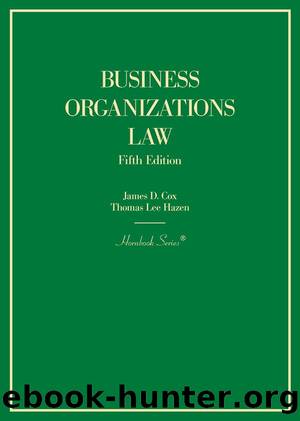Business Organizations Law by James D. Cox & Thomas Lee Hazen

Author:James D. Cox & Thomas Lee Hazen
Language: eng
Format: epub
ISBN: 9781642424010
Publisher: West Academic
Published: 2020-10-15T00:00:00+00:00
Implied Private Action Under Rule 14aâ9
The first time that the Supreme Court gave its imprimatur to an implied cause of action under the securities acts was with regard to Rule 14aâ9âs antifraud limitations on the use of the proxy machinery.363 J.I. Case Company v. Borak364 involved a shareholderâs claim of misleading statements in managementâs solicitation of 410
shareholder support for a proposed merger.365 The Court relied on the legislative history supporting section 14(a) as requiring basic standards of honesty and the necessity of managementâs affording at least certain minimum intra-corporate rights to shareholders.366 While there is a serious question concerning the Supreme Courtâs continued willingness to imply additional private remedies, under the federal securities laws the Rule 14aâ9 implied private cause of action, like the implied cause of action under Rule 10bâ5, can no longer be questioned.367
It is important to bear in mind that the coverage of the proxy rules is limited. In addition to applying only to solicitation of proxies by Exchange Act reporting issuers,368 section 14(a) necessarily applies only to issues that are brought before the shareholders for a shareholder vote.
Materiality. The dominant concern in any action under Rule 14aâ9 is whether the proxy solicitation contained a material omission or misstatement of fact. A factâs materiality is a mixed question of law and fact that arises in pretrial motions as well as at trial. TSC Industries, Inc. v. Northway, Inc.369 is the leading case on the standard to be applied in deciding whether an omission or misstatement is material:
An omitted fact is material if there is a substantial likelihood that a reasonable shareholder would consider it important in deciding how to vote. This standard is fully consistent with Millsâ general description of materiality as a requirement that âthe defect have a significant propensity to affect the voting process.â It does not require proof of a substantial likelihood that disclosure of the omitted fact would have caused the reasonable investor to change his vote. What the standard does contemplate is a showing of a substantial likelihood that, under all the circumstances, the omitted fact would have assumed actual significance in the deliberations of the reasonable shareholder. Put another way, there must be a substantial likelihood that the disclosure of the omitted fact would have been viewed by the reasonable investor as having significantly altered the âtotal mixâ of information made available.370
Subsequent Supreme Court decisions have refined without limiting this standard of materiality. Thus, in Basic, Inc. v. Levinson,371 the court held that the standard for determining materiality for soft information, such as financial forecasts, appraisals, and future financial expenditures, that âmateriality will depend at any given time upon a balancing of both the indicated probability that the event will occur and the anticipated 411
magnitude of the event in light of the totality of the company activity.â372 Under this sliding scale standard, an event with a low probability of occurrence can nevertheless still be material if its occurrence will have a significant impact on the companyâs net worth or profits. Thus, in Basic, Inc.
Download
This site does not store any files on its server. We only index and link to content provided by other sites. Please contact the content providers to delete copyright contents if any and email us, we'll remove relevant links or contents immediately.
The Social Psychology of Inequality by Unknown(2323)
The Plant Paradox by Dr. Steven R. Gundry M.D(2055)
The Writing on the Wall by Anselm Jappe(1764)
Working for Yourself by J.D. (Nolo) Stephen Fishman(1484)
Every Landlord's Legal Guide by Janet Portman & Stewart Marcia & Ralph Warner(1334)
The First 20 Hours: How to Learn Anything ... Fast by Kaufman Josh(1311)
ADHD on Trial by Michael Gordon(1247)
Decisive by Chip Heath(1204)
Drafting Contracts: How and Why Lawyers Do What They Do, Second Edition by Stark Tina L(1181)
Working for Yourself by Stephen Fishman J.D. (Nolo)(1147)
The Economist Aug 8th 2015 by The Economist(1126)
Restitution by Restitution(1119)
The Economist Aug 29th 2015 by The Economist(1101)
The Lord of the Rings: The Fellowship of the Ring, the Two Towers, the Return of the King by J. R. R. Tolkien(1089)
Intellectual Property Strategy by John Palfrey(1088)
A Practical Guide to International Arbitration in London by Hilary Heilbron(1087)
Collusion by Luke Harding(1048)
Persuasion by Owner(1021)
Chapter 1 by Owner(957)
